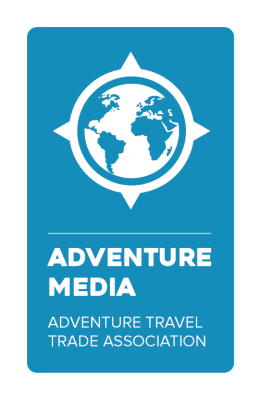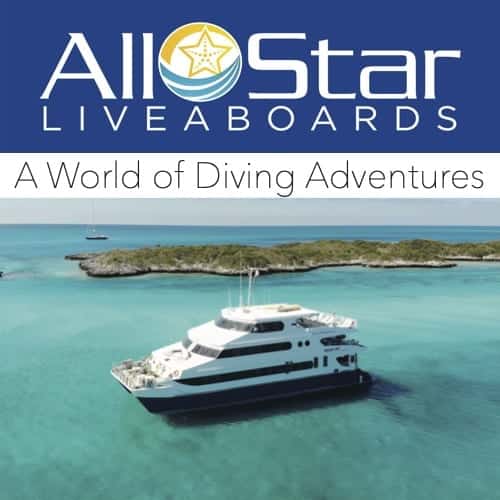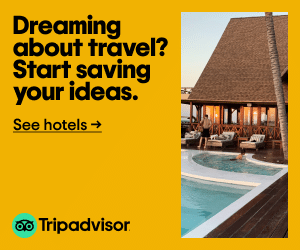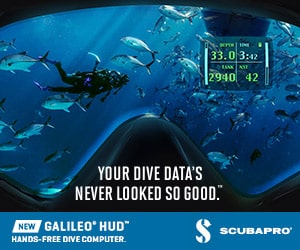How unique are the Florida Manatees? Crystal River is the only place in the world where you can swim with manatees in sparkling clear spring water and the largest natural manatee aggregation in the world. Almost half of the world’s West Indies manatees live in Florida. These gentle giants can weight over 1,000 lbs and swim up to 16 MPH. They have no aggressive or territorial behavior since they are herbivores without natural predators. Combine that with their extremely low metabolism, and you have a giant aquatic animal that behaves like a sloth or a koala bear. No wonder more than 20 million visitors come to see manatees in Florida every year.
These amazing creatures have lived for millions of years. They survived changing seas and rising mountains. However, they might not be able to live alongside man. All around the world, manatees are on the brink of extinction, except in Florida. Here, eco-tourism has shown people the beauty of manatees and educated the public on how to protect them. After decades of increased awareness, the manatees in Florida have recovered enough to be removed from the endangered list. Their status has been upgraded to “threatened” with plans to create a healthy and self-sustaining population.
Keep reading to hear our first-hand accounts of manatee encounters including swimming with manatees and the results of our research about where manatees come from and what you can do to ensure their survival for generations to come.

Swimming with Gentle Giants of Florida
Our captain killed the engine and gave us our final instructions before entering the water. Keep a body length separation between you and the manatee. Don’t ever chase or pursue a manatee. If you swim softly and float like a manatee, they might come up to you on their own, but only if you’re very mellow.
With those words, we entered the 72-degree spring water. It was a little chilly, even in a wetsuit, but warm enough for the tropical manatees to overwinter here. We kicked away from the boat and ducked under the ropes that defined the swim-only area around the springhead. After a few more kicks, we could see the manatees sleeping on the sandy bottom through the clear spring water.
Jenn signaled for me to look at a mother-calf pair. Then she held her arms open wide to say there were huge and then tapped her heart to say she was in love.
Mom was enormous. She must have been at least 10′ long. Patches of algae clung to her grey-brown skin. A few barnacles grew along her back indicating she was one of the hundreds of manatees that migrated to Crystal River from the open ocean and not part of the 40 or so year-round resident manatees. Our captain told us the local manatees don’t have any barnacles since they don’t venture far into the open ocean. A couple of healed scars revealed where she had a previous boat encounter. In fact, every adult manatee we saw had at least one such injury. Boat strikes are the single leading killer of manatees, and it appears non-lethal strikes are quite commonplace.
Baby was smooth and beautiful, about the same size and shape as the harbor seals we knew and loved from San Diego. We later learned that manatees are more closely related to elephants than seals or sea lions. The similarities to seals come from the convergent evolution of ocean mammals. Like sea lions and seals, they can be friendly and curious. We hoped that baby would come to us, but she’s a wild animal, and the choice has to be hers.
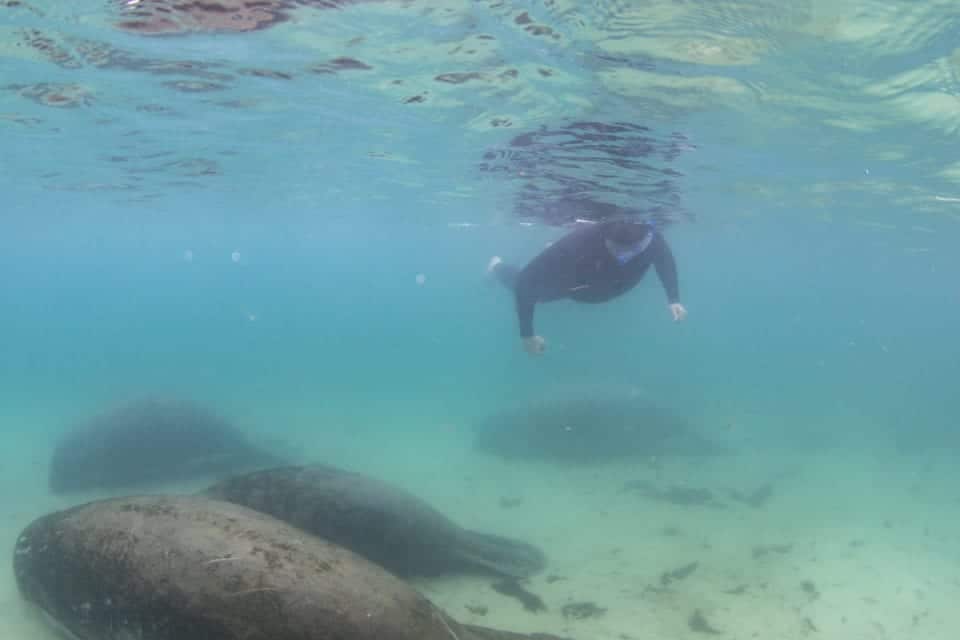
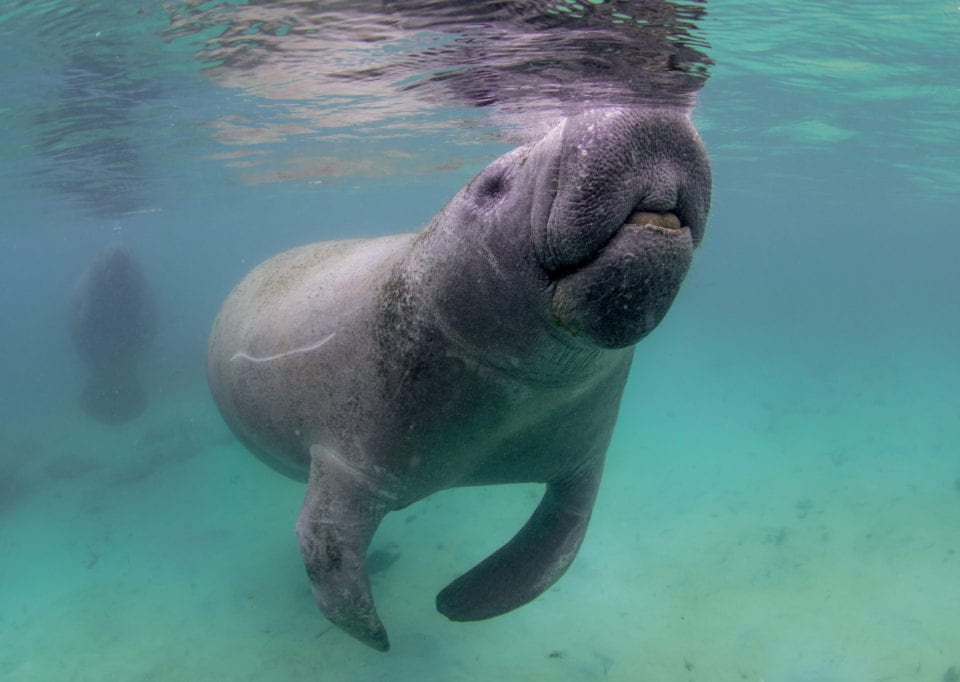
Florida Manatee Encounters
We floated on the surface staying as still as possible just like our captain instructed. After a couple of minutes, mom surfaced to breathe. She rose straight up until her nose broke the surface of the water, took a deep, audible breath, and settled down to the bottom, taking no notice of us at all. When baby surfaced, all of our manatee encounter hopes and dreams came true.
Baby rose up, just like mom, but she stayed at the surface. With a flick of her paddle-like tail, she closed the gap between us. We couldn’t decide if she was beautiful, or just so ugly she was cute. Her face was wrinkled like a poorly made sock puppet and covered with whiskers that she used to navigate murky water. She nuzzled into us, letting her bristly lips feel our legs like an elephant reaching for a peanut. There was no aggression or fear on either side, just mutual curiosity.
After visiting us, she went to the calmer members of our party to check them out too. She was graceful, curious, and playful, almost like a puppy. After investigating the new visitors to her spring, she settled back down next to mama and appeared to fall asleep immediately.
There were about a dozen manatees in the springhead, and our captain found several other manatee hot spots that day. We know manatees are wild animals, and no encounters are guaranteed, so we felt like we hit the lottery when baby swam up to see us. We wanted to learn everything we could about where manatees came from and how we could help protect them.
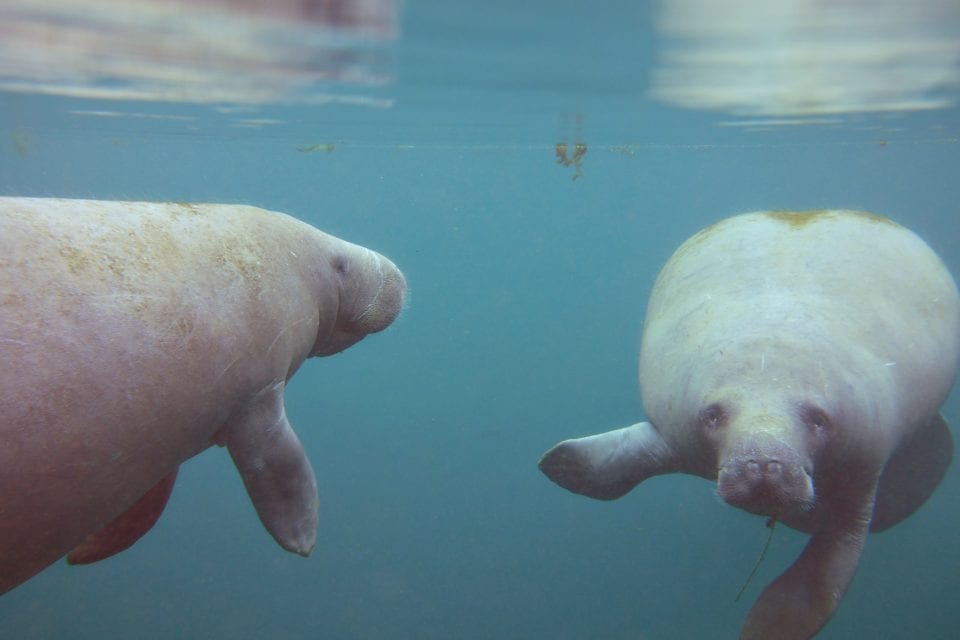
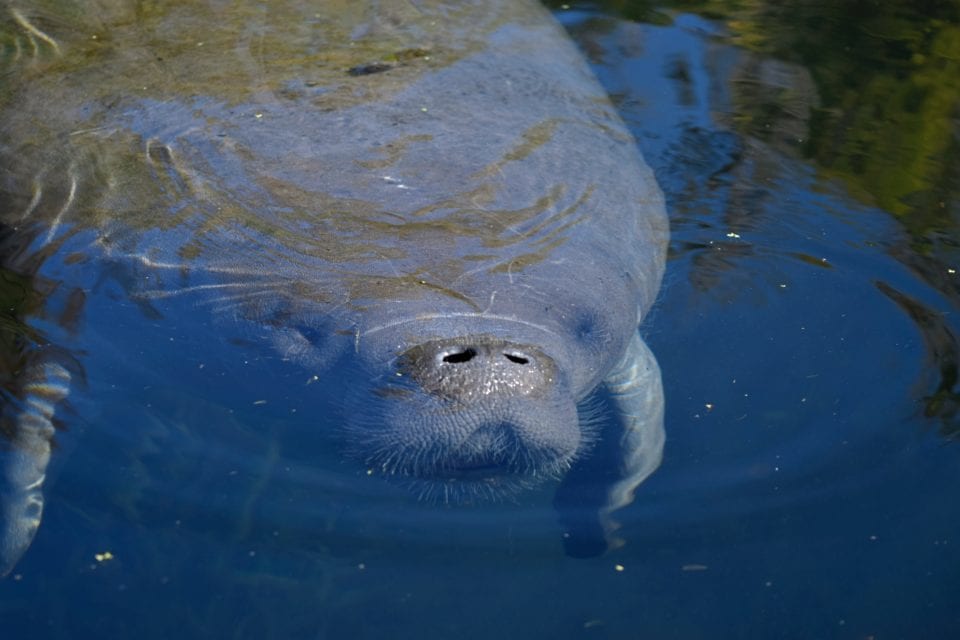

Manatees of the World
Manatees are members of the Sirenia family. That name might sound familiar to Greek Mythology buffs. Sirens are the mythical creatures who seduced sailors on long voyages. Legend has it that sailors mistook manatees for mermaids after spending too long at sea. There are only four living Sirenia species. One species of Dugongs that inhabit the tropical coasts along the Indian and Pacific Oceans and three species of manatees live along in the tropics of Atlantic Ocean.
These manatee species diverged millions of years ago as their habitats became isolated and specialized. The Amazonian Manatee evolved about 50 million years ago when the Andes rose up, and the Amazon Basin turned from a shallow sea to a freshwater drainage. They are the smallest of all manatee species and the only ones to live exclusively in freshwater. The African manatee crossed the Atlantic a couple of million years ago during the late Pliocene Period to live off the coast of West Africa. They are closely related to the final species of manatees, the West Indies manatee, that live in Florida and the Caribbean. A fifth species, Steller’s sea cow, lived in the sub-Arctic waters of the Bering Sea not so long ago. Steller’s sea cows reached a whopping 25′ long, but humans hunted them to extinction within 27 years of their discovery. The last Steller’s sea cow was killed and eaten in 1741.
West Indies manatees have two subspecies, the Antillean manatee and the Florida manatee. The Antillean manatee lives throughout the Caribbean while the Florida manatee lives only in Florida. Technically, they winter in Florida. During the summer months, they spread out as far west as Texas and as far north as New York. Despite their large summer range, they rarely cross over between the west coast of Florida and the East coast.
Manatee Location Map Below. If it doesn’t load, refresh your browser 🙂
Manatee Locations in Florida
The question – where are manatees located in Florida has been a subject of much academic research. It’s hard to count manatees in the summer because they disperse across a broad area and tend to live in murky water.
What makes Florida unique in all of the manatee habitats is that the entire population gathers in a few warm water spots in the winter. If it wasn’t for springs pumping out 72-degree water, manatees couldn’t survive this far north. West Indies manatees cannot live in water below 68 degrees, so they need these warm water resources, and we get to witness manatee aggregations that happen only in Florida.
Scientists developed aerial survey techniques for counting manatee populations as the converge on warm water sources during cold winter days. When aerial surveys began in 1991, only 1,267 manatees lived in Florida. In 2001, the total population reached 3,276. Today, it has grown to over 6,300 and counting thanks to conservation efforts.
The Florida Manatee Recovery Plan calls out 20 different locations where large communities of manatees gather during the winter. We mapped these locations on Google Maps to show the diversity of winter habitats. Simple blue pins mark manatee aggregations of 25-100 animals. Blue stars mark populations greater than 100. Most of these sites are not well suited for public viewing; they simply illustrate how many manatee sites there are and how closely manatees live with people. The best places for winter manatee viewing are highlighted in orange and listed below:
- Blue Springs State Park – 2100 W French Ave, Orange City, FL
- Manatee Education and Observation Center – 480 N Indian River Dr, Fort Pierce, FL
- Manatee Lagoon – 6000 N Flagler Dr, West Palm Beach, FL 33407
- Crystal River/Three Sister Springs – 123 US-19, Crystal River, FL
- Homosassa Springs – Springs 9350 W Fishbowl Dr, Homosassa, FL
- Tampa Electric Manatee Viewing Center – 6990 Dickman Rd, Apollo Beach, FL
- Manatee Park – 10901 Palm Beach Blvd, Fort Myers, FL
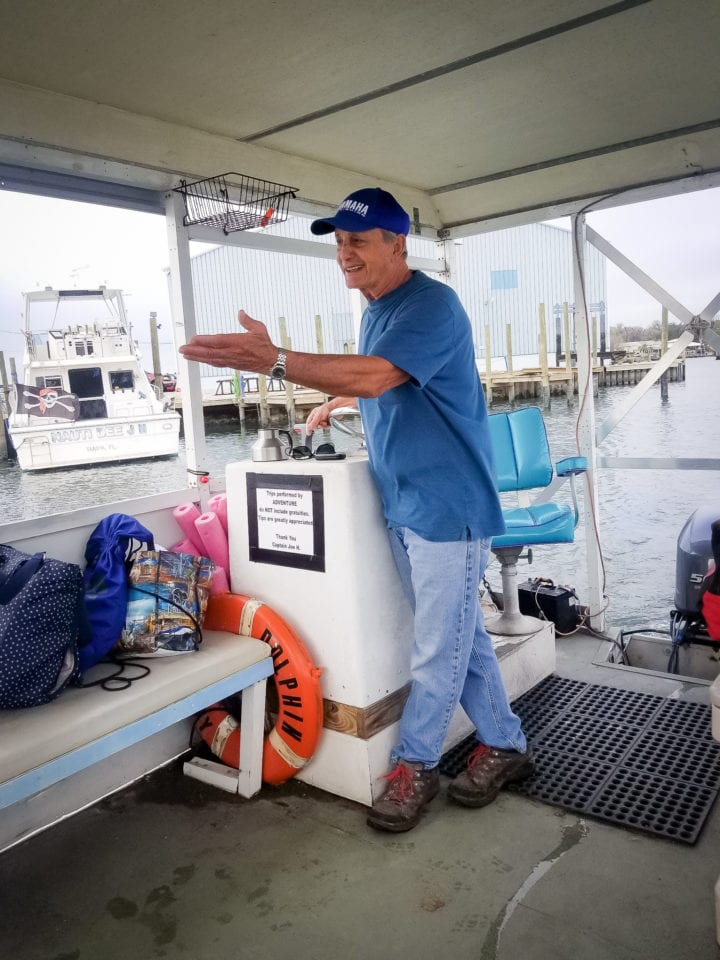
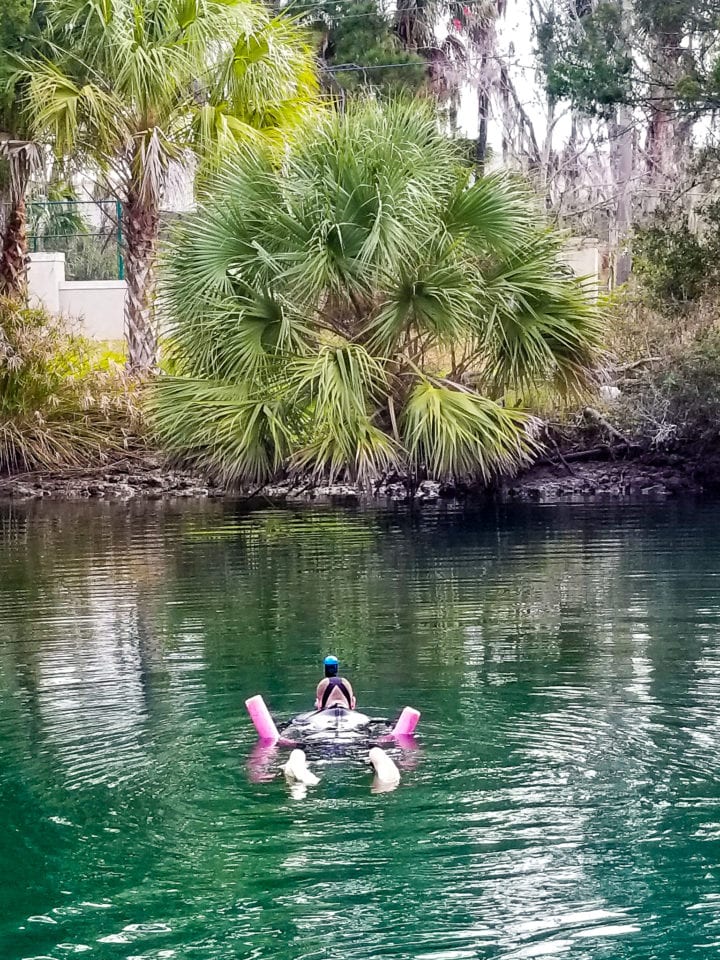
Does Tourism Help the Manatees?
The Florida Manatee Recovery Plan (FMRP) relies on media outlets, like this site, to increase public awareness of manatees. The FMRP states – “Media coverage of manatee rescues, treatments, and releases helps to educate millions of people about manatees, the life-threatening problems that they face, and actions that can be taken to minimize the effect of anthropogenic activities (originating in human activity) on this species [manatees]. In addition, more than eighteen million visitors a year see manatees at rehabilitation facilities and participate in manatee education programs sponsored by several parks. The publicity and outreach inherent in this program provide significant support to efforts to recover the manatee.”
The FMRP goes on to say “Manatee viewing opportunities have also been made available to the public…. Such efforts are essential for obtaining public compliance with conservation measures to protect manatees and their habitats. Many public awareness materials have been developed specifically focusing on boater education. “
Population modeling from scientists like Eberhardt and O’Shea, Marmontel, and Langtimm show that manatee population trends are most sensitive to changes in adult survival rates. The FMR says “The most significant problem presently faced by manatees in Florida is death or injury from boat strikes.” Nearly 25% of manatee deaths are from boat strikes. Manatees tend to have one baby every two to three years and live and a lifespan of up to 50 years, so every death is critical. Even though the numbers of boats in Florida has skyrocketed, the strikes per registered boat have gone way down, thanks to increased public awareness.
The FMRP data also shows that Crystal River has one of the highest survivability rates of any Florida site which implies that the interactions with humans aren’t harming the population when done correctly.
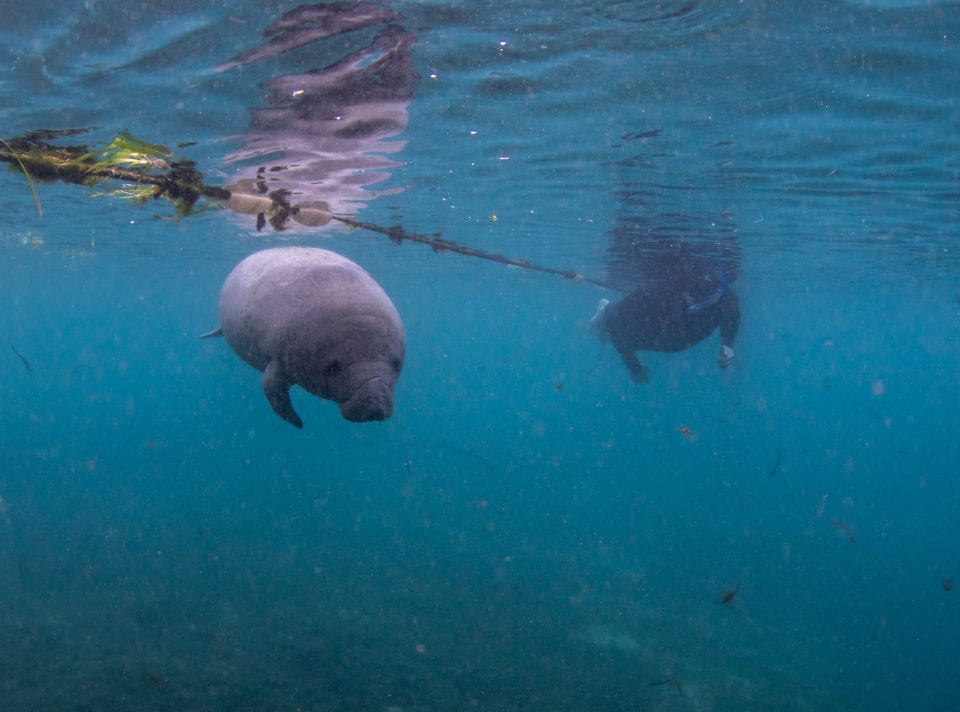
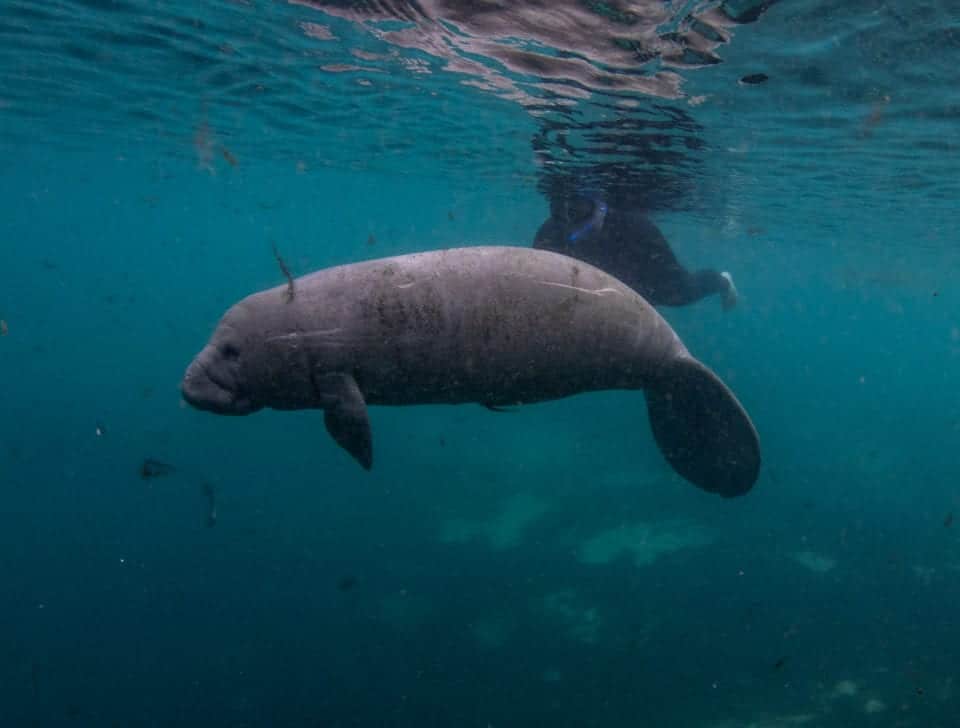
Self Guided Manatee Tours
After our first incredible manatee tour, I wanted to return as a private boater. There were some great moments on the return trip, like meeting Eric Fisher. He is a fantastic photographer, a wonderful conservationist, and an even better person. He took a lot of the photos you have seen in this article including the title shot. You should check out his site to see more of his work (maybe after finishing this article). Despite meeting some cool people, there was one negative moment that keeps replaying in my mind.
A family brought their 10-year-old boy to go out swimming in the bay. He excitedly reported that there were manatees in the water. I felt terrible at how ill-prepared he was for the swim. He had no flotation, no wetsuit, no snorkel, and no mask. He was just flopping around in the cold water. He would have probably given up without really seeing a manatee had I not intervened. Instead, I created a situation.
At first, I loaned him my mask and snorkel. He refused the snorkel and flopped back out to the manatees. I could tell this wasn’t working and called him to us to put on a life vest from our boat. At least now he was at the surface, but without a proper a snorkel, insulation or instruction he was still moving around entirely too much.
We called him back again to remove the gear. This encounter just wasn’t working. The boy was extremely appreciative, but I knew this was a situation I didn’t want to repeat. That is why I encourage everybody to take a guided manatee tour at Crystal River. They will provide you with all of the gear that you need and proper instruction on how to have an ethical encounter.
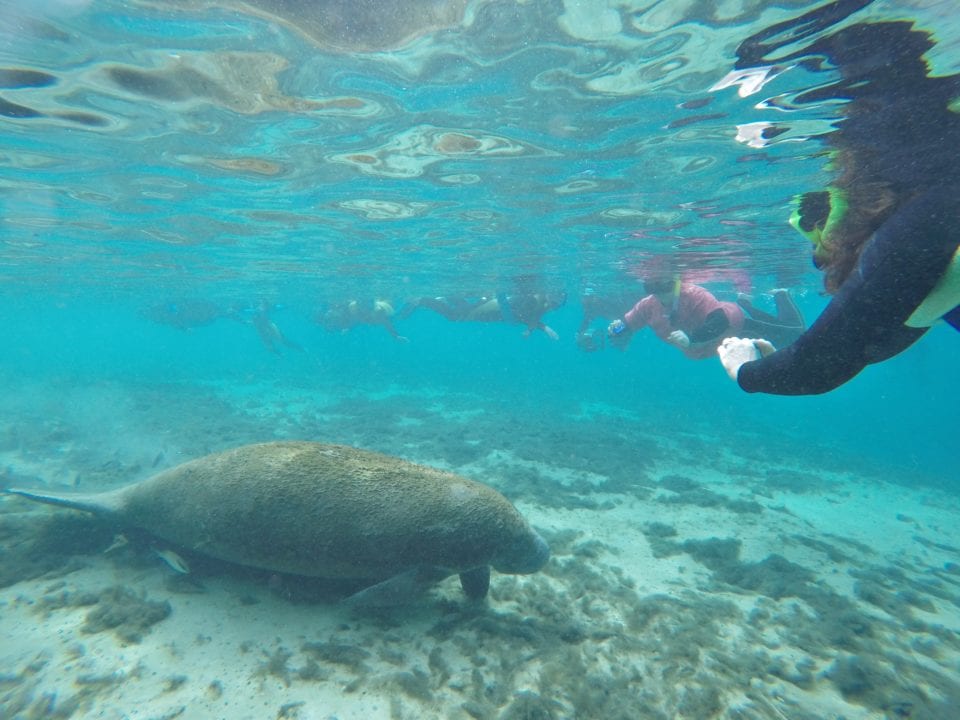
Guided Manatee Tours
After returning from my private tour, I took a walk to a well-renowned tour operator in Crystal River – Bird’s Underwater – to learn more about ethical manatee tours. I wanted to meet with this shop in particular because they were an early member of the group META (Manatee Ethical Tourism Association). I met with Jeff Sandmann, a boat captain for Bird’s for the last 15 years. He said every tour (and everybody wanting to see and interact with manatees in general) should start with the film Manatee Manners, which we include below. (You’ll even see Jeff’s name in the credits as Plantation Dive Shop). This video re-iterated META’s best practices for manatee encounters:
- See to the safety and well-being of our passengers as our first and highest priority.
- Know and obey the relevant environmental regulations.
- Conduct ourselves in a professional manner at all times within our function as guides and educators.
- Uphold a policy of passive interaction with manatees.
- Assure that all passengers know and obey all sanctuary zone restrictions.
- Show courtesy to fellow operators by not “dropping on” or “dumping on” another’s group during a manatee swim interaction.
- Strive to be cooperative members of the community.
- Represent ourselves as environmental ambassadors of the area.
- Report any infractions to the proper law enforcement agency.
People Protecting Manatees
Jeff said, “We protect the things we love.” He said when he first came to Crystal River, many people viewed manatees as funny looking speedbumps. Now, manatees and manatee tours are an integral part of the town culture. There are still people who visit who don’t exercise manatee manners, so he has to remove aggressive or disruptive passengers from the water. I view this level of on-site management as a massive benefit from the ecotourism industry.
There are other groups besides META acting in the best interest the manatees. Save the Manatee Club is active worldwide. They are using some of the lessons learned from the Florida manatee recovery to help all of the world’s manatees as well as continuing to protect and promote the Florida manatee. One Rake at a Time began with local homeowner Art Jones removing the invasive plant Lyngbya from behind his house. The group has grown to organize large-scale Lyngbya cleanups that have visibly increase the water quality (and manatee food sources) around Crystal River and Kings Bay. An extensive network of citizens, scientists, public officials, and activists are banding together to help protect the manatees and their environment.
Only a handful of manatee tour operators are current META members, but each shop has a personal interest in protecting the manatees, especially the local shops of Crystal River. Ken Milby, an owner of SeaDaddys, believes that group size is a significant factor in manatee protection. He focuses on small group tours to reduce the stress on the animal and allow for better interactions for his guests. Jeff S. described the vigilance of the Crystal River tour operators best. “It is in our best interest to do the right thing. You will get people to self-police if it’s in their best interest. ” The manatees of Crystal River are lucky to have such a large and diverse group of people acting in their best interest.

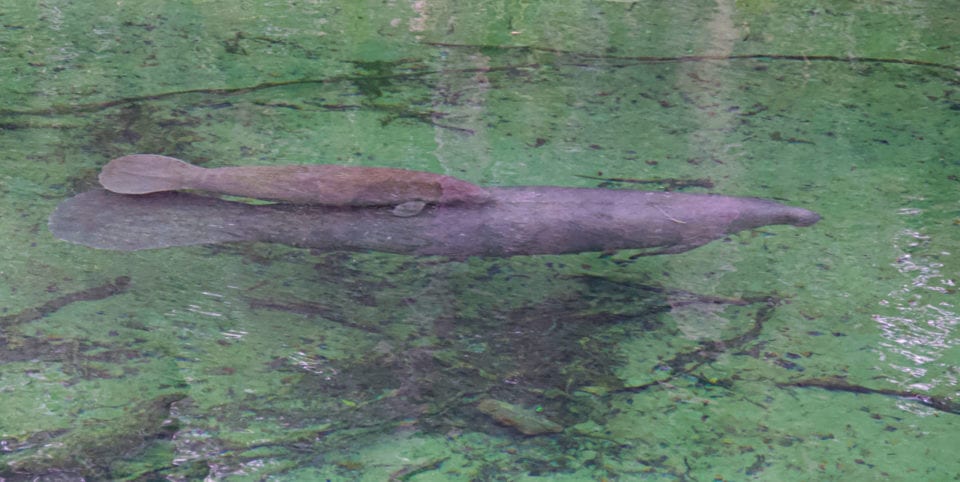
Manatee Facts
I have compiled some quick manatee facts to help you learn more about manatees and manatee tours.
- Lee County put out an excellent free manatee activity book . (well worth a click)
- Manatees are solitary animals except the mother/calf bonding which can last up to two years.
- Manatees eat up to 10% of their body weight daily.
- It takes 7 days for food to pass through a manatee.
- In-water access to Three Sisters Springs can be closed by USFWS when water temperatures in the Gulf Of Mexico drop below 62.2 degrees Fahrenheit.
- Find out if the Three Sister Springs are open or closed for in-water access by visiting the Crystal River National Wildlife Refuge Complex Facebook page.
- Manatees tend to gather in warm water when the water temperature drops below 68 degrees.
- Find out the temperature of the Gulf of Mexico on the USGS monitoring website for Shell Island at Crystal River.
- Manatees closest living relative is the elephant.
- Manatees tend to return to the same sites every year.
- Peak manatee season is November through March, but manatee tours in Crystal River run year round and there are several other summer viewing locations as well like Silver Springs.
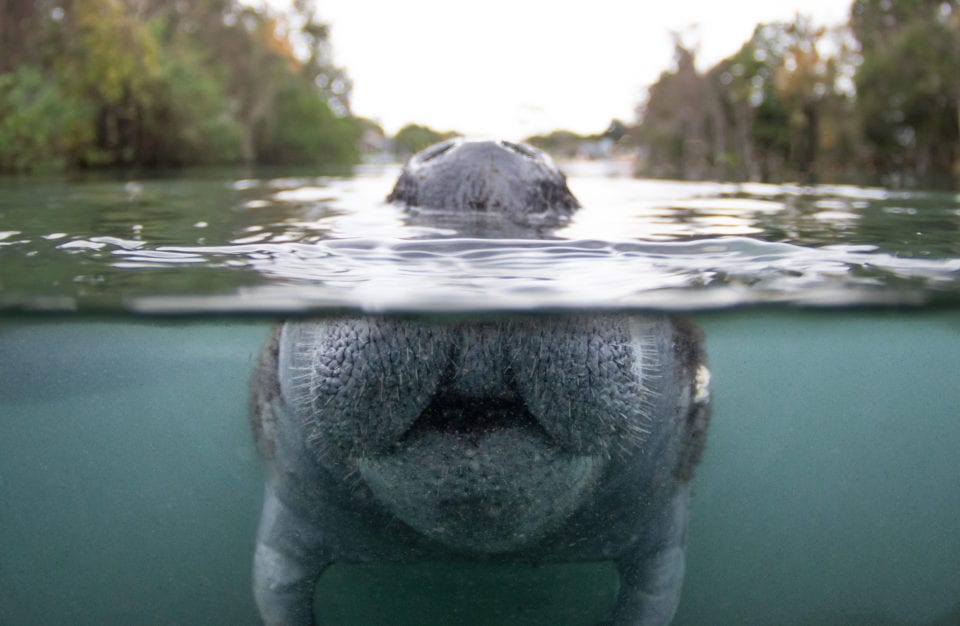
Final Thoughts on Seeing Florida Manatees
We fell in love with manatees when we came to Florida. Swimming with manatees in Crystal River is a unique life event that you can only do in Florida. We’ve also paddled with manatees and monkeys in Silver Springs, visited manatees in Blue Springs Park, went to the manatee viewing station on Merritt Island, and saw manatees kayaking in Cayo Costa. We prefer to see manatees in the springs because the water is so much clearer. I wouldn’t turn down an opportunity to see manatees, but you absolutely have to see them in the springs once in your life. Be warned, you just might fall in love.
Like it? Pin it for later on Pinterest!
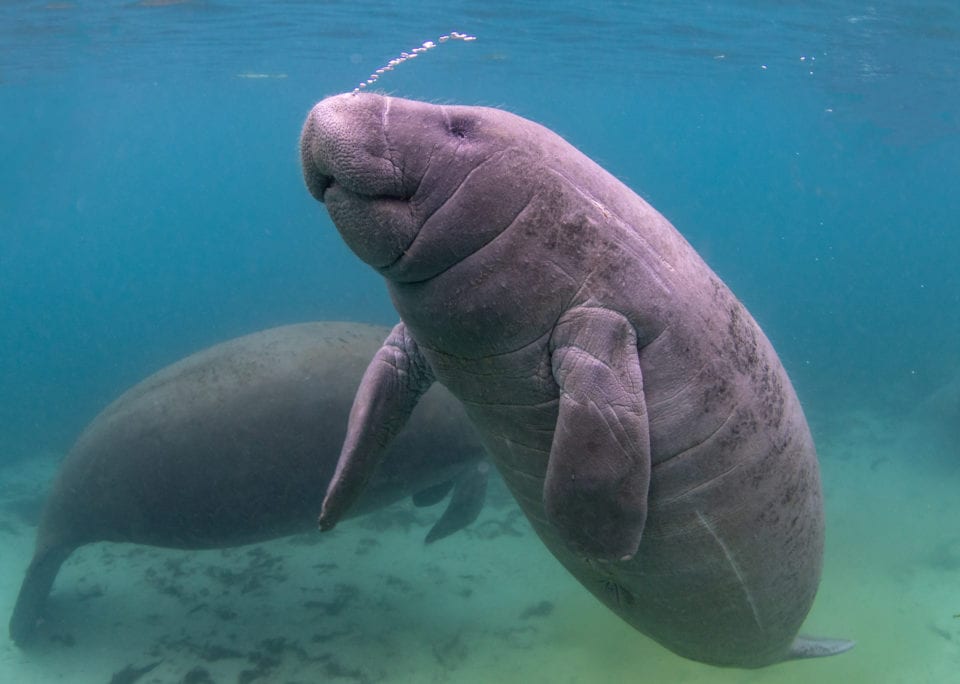
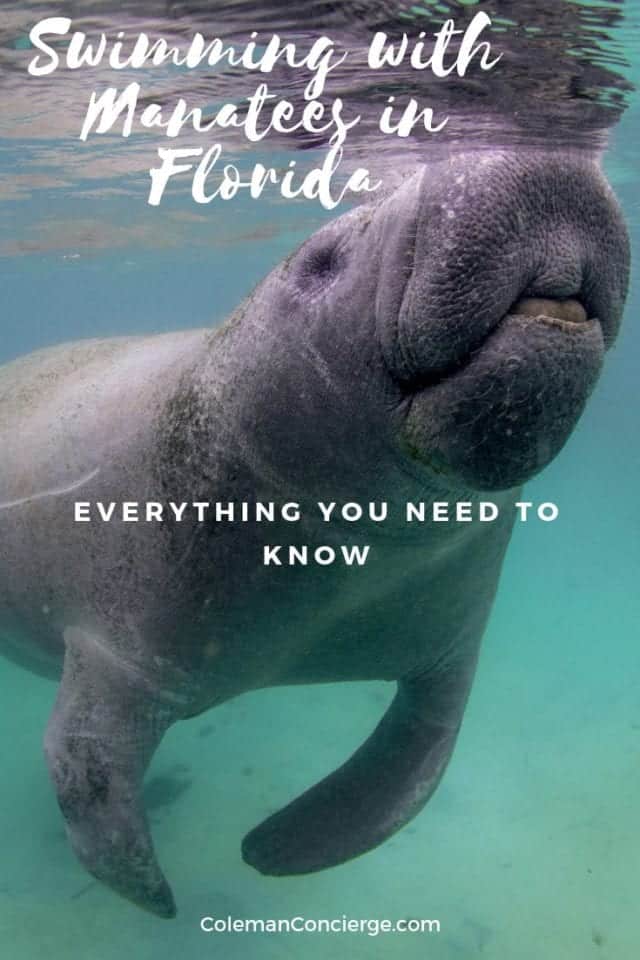
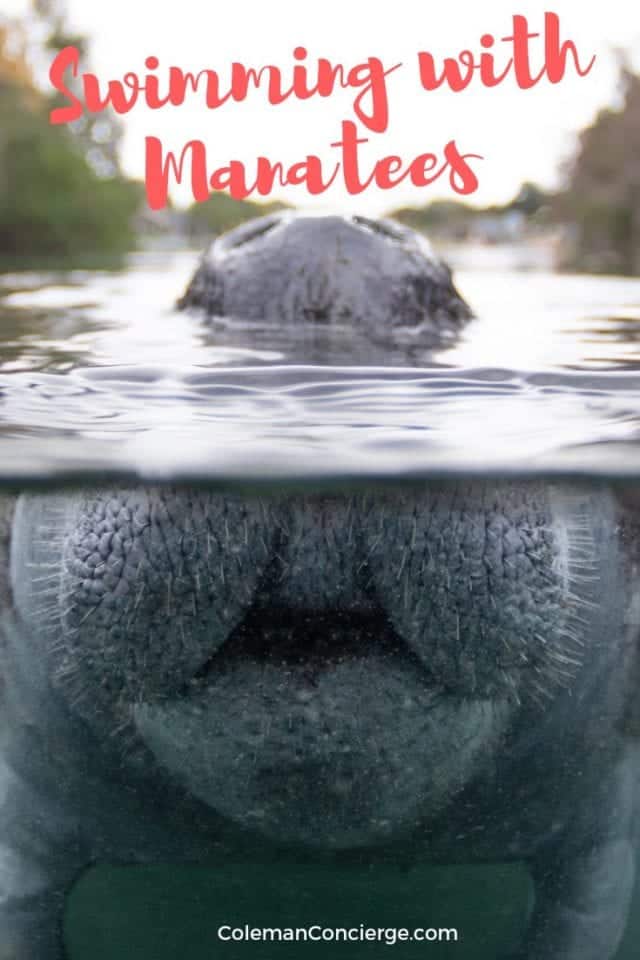
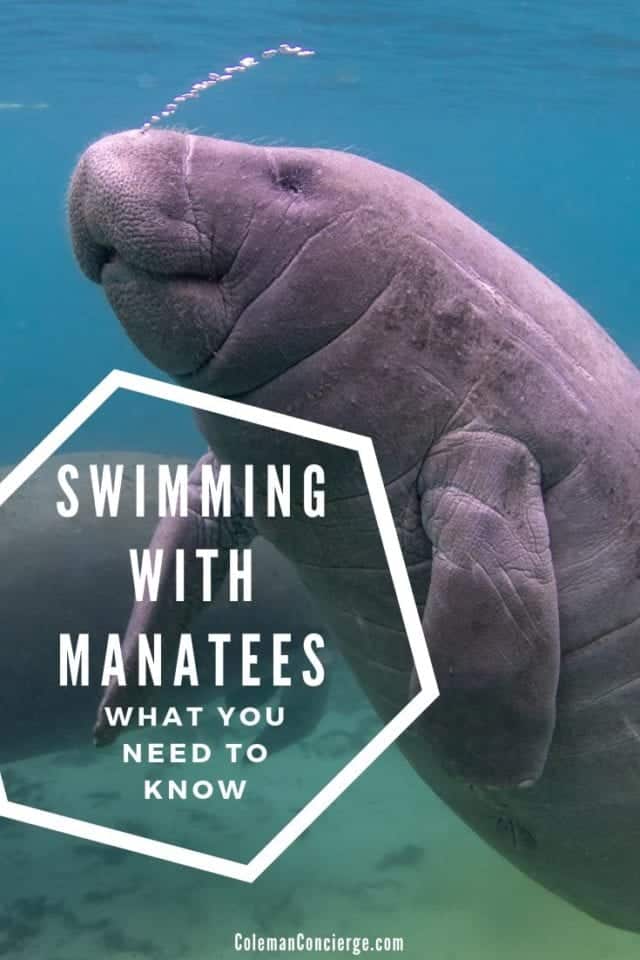
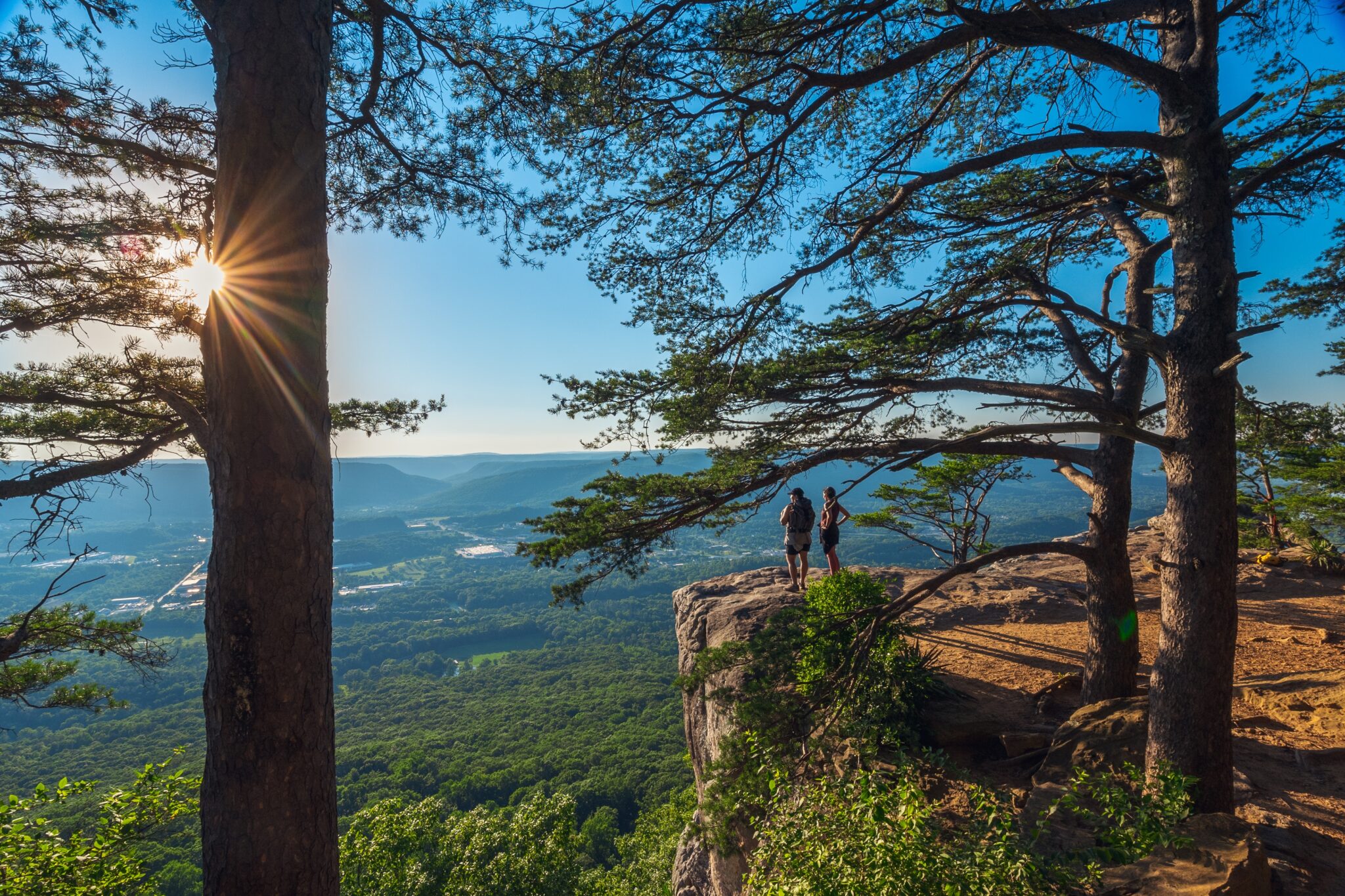
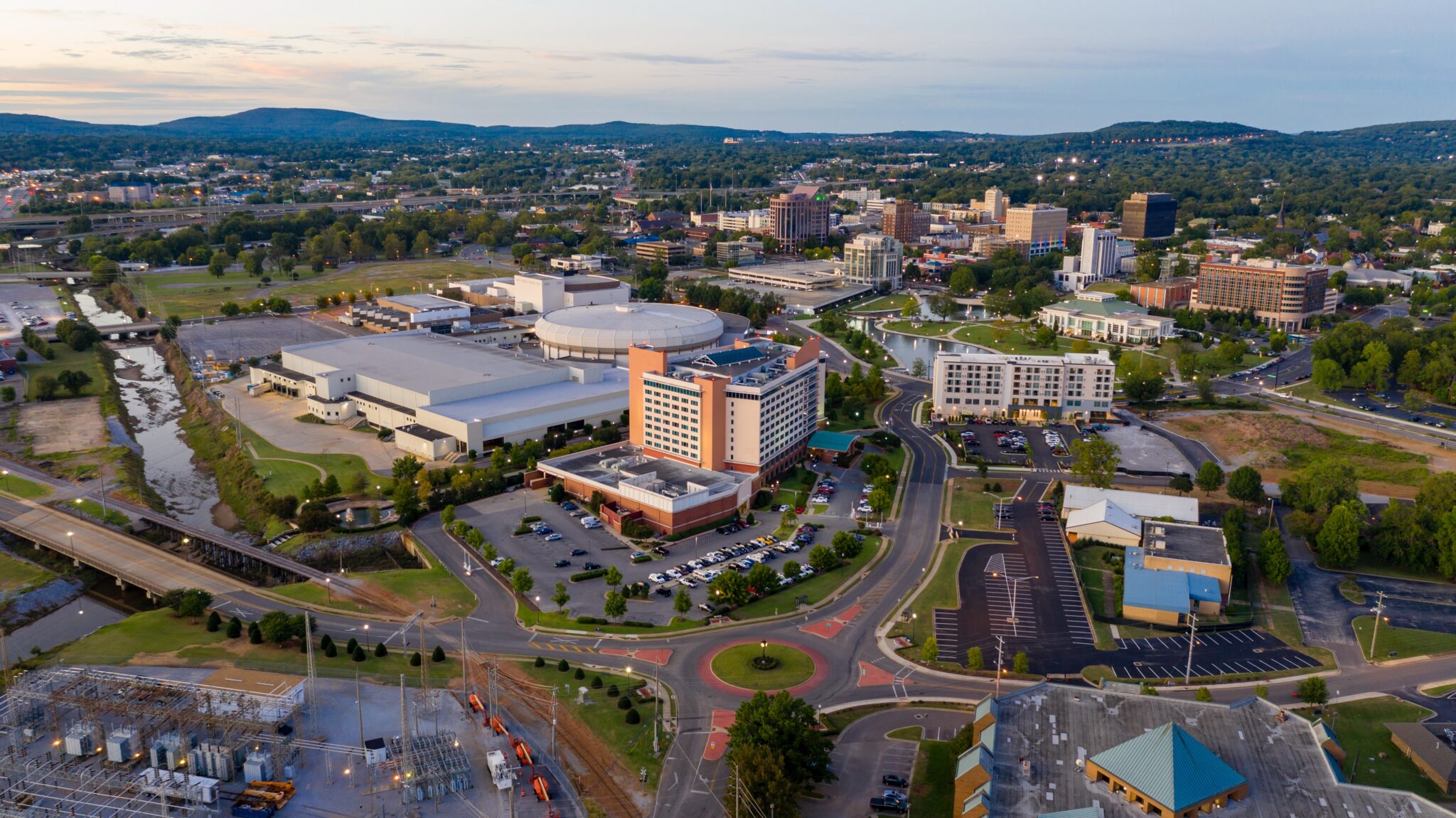
 Hi! We are Jenn and Ed Coleman, and together we are Coleman Concierge. It is our goal to inspire you to get out, expand your world, and to seek adventure, even in your own backyard.
Hi! We are Jenn and Ed Coleman, and together we are Coleman Concierge. It is our goal to inspire you to get out, expand your world, and to seek adventure, even in your own backyard.


